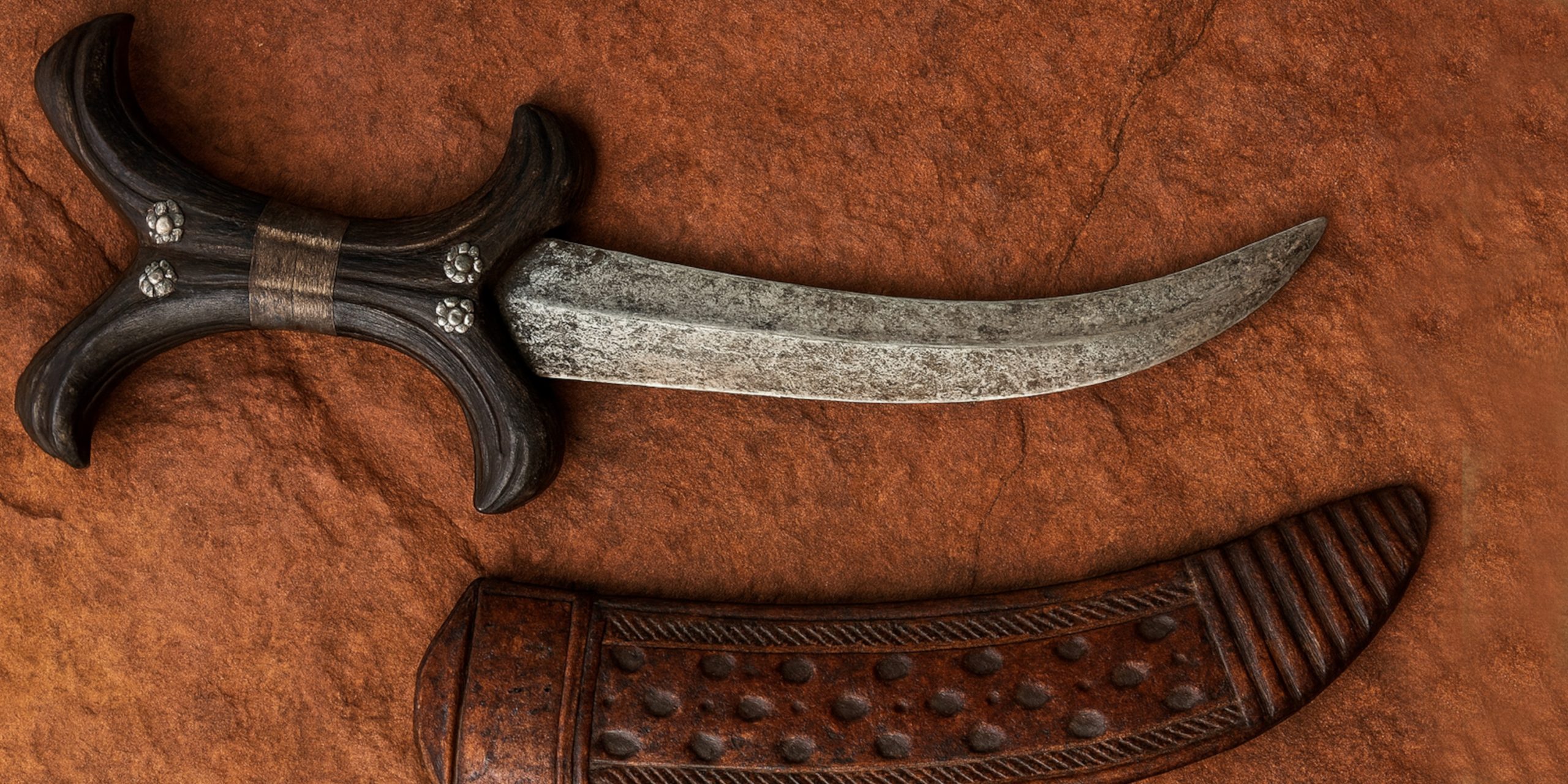
The Beja dagger, often referred to as the Hadendoa knife, is a traditional weapon associated with the Beja people, a semi-nomadic group found in eastern Sudan, southeastern Egypt, and parts of Eritrea. Among these tribes, the Hadendoa and Beni Amer are especially known for their distinctive daggers. The weapon serves as both a practical tool and a cultural emblem, often worn visibly as a symbol of identity and status.
Specification
| Feature | Description |
|---|---|
| Blade | Double-edged steel, often curved or in a hooked “dog-leg” form, sometimes with a raised central ridge. |
| Hilt | X-shaped, typically carved from ebony or dark hardwood. Many are wrapped in silver wire and inlaid with brass or silver detailing. |
| Sheath | Leather, often tool-embossed, sometimes braided or fitted with metal mounts. |
| Size | Overall length: approx. 33 to 38 cm (13–15 in); blade length: around 23–25 cm. |
| Weight | Varies depending on materials; generally lightweight for portability. |
History and Evolution
The Beja people are believed to descend from ancient Cushitic-speaking populations, with some theories linking them to displaced ancient Egyptians around the 8th century BC. Their weaponry evolved alongside their nomadic and warrior culture, which prioritised portability, resilience, and symbolism. The dagger’s curved form and the distinctive X-shaped hilt appear to reflect influence from Indo-Arabic weapons, particularly the South Indian chilanum, though the Beja version has evolved its own aesthetic and function.
These daggers were not mass-produced. Each one was hand-crafted by regional smiths and often customised for the owner. The presence of silver, engraving, and detailed leatherwork indicates the status of the wielder within their community.
Advantages and Disadvantages
- Advantages
- Curved blade improves slicing in close-quarters combat.
- X-hilt protects the hand and offers a firm, ergonomic grip.
- Decorative and cultural value enhances its symbolic importance.
- Durable and portable for nomadic use.
- Disadvantages
- Curved shape limits its utility outside combat.
- Silver or decorative inlays may weaken structural integrity.
- Less versatile than broader-bladed knives or utility daggers.
Comparison with Similar Weapons
The Beja dagger shares some visual and functional traits with the South Indian chilanum, particularly in the curved blade and prominent hilt. However, the Beja version is more rugged and rooted in tribal identity. Compared to the Tuareg takouba or the Ethiopian shotel, the Beja dagger is smaller, more personalised, and generally less standardised.
Legacy
Today, the Beja dagger remains a cultural relic, worn during ceremonial occasions or preserved in collections. It is recognised not only for its striking form but for what it represents: a people’s resilience, history, and craft. Museums in the UK and Europe have included Beja daggers in ethnographic and arms collections, underscoring their historic value.
Where to See
- Pitt Rivers Museum, Oxford: Contains examples collected during early 20th-century expeditions.
- British Museum, London: Holds a Beja dagger collected in Sudan in the 1930s.
- Private Collections: Many daggers reside in personal collections across Europe and North America.
- Ethnographic Exhibitions: Occasionally displayed in African or colonial-era exhibitions.
Collector’s Guide and Auction Prices
Collectors typically look for:
- Age and provenance
- Blade curvature and forge quality
- Intact silver wire or inlay work
- Original sheath condition
- Museum or field collection records
Recent Auction Examples:
| Date | Description | Price Range |
|---|---|---|
| 2024 | 19th-century example with silver hilt and sheath | £600 (pair lot) |
| 2023 | Beja dagger with worn leather sheath | £340 |
| 2022 | Mid-19th-century piece with brass inlays | Unsold (est. £300–400) |
| 2021 | Plain example with basic leather sheath | £30–£100 |
Prices vary based on condition and provenance. Daggers with documentation or field-collected examples from known expeditions generally command higher values.



